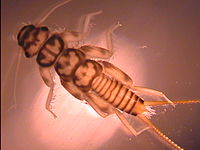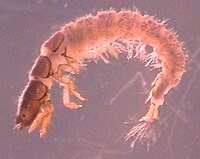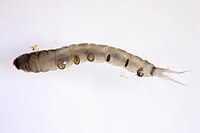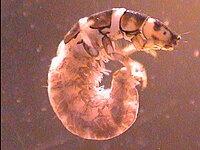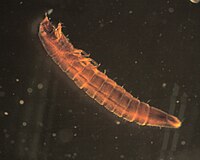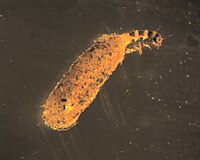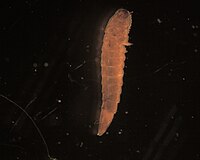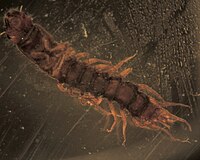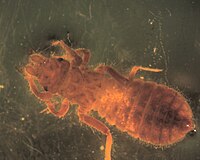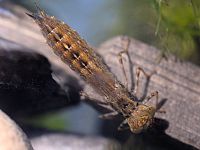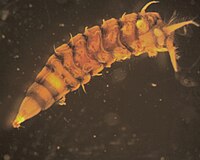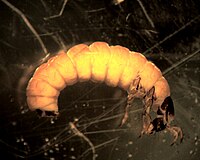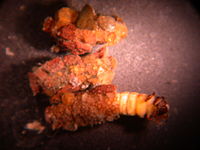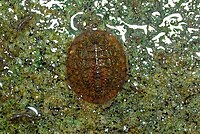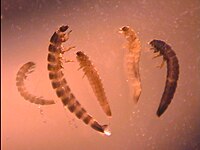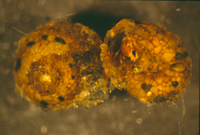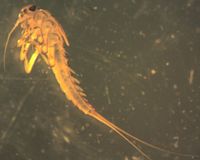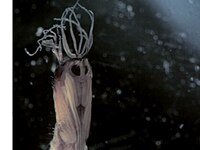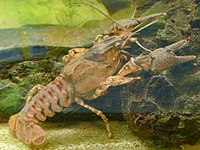Vermont EPSCoR's Streams Project; A Teacher Collaboration on WikiEducator
Openly shared content, practices, and developing resources from Vermont EPSCoR's Streams Project. Join this collaboration and make a difference!
 Potash Brook |
|---|
|
| Stream code: | LCD_PoBrk_133 |
| Basin: | Winooski Basin |
| State or Province: | Vermont |
| Country: | USA |
| Latitude: | 44.44663 |
| Longitude: | -73.20401 |
| School: | Rice Memorial High School |
The following are the most common invertebrates collected from this stream site.
Chironomidae
- Order
- Diptera
- Family
- Chironomidae
- Common name
- Nonbiting midge
- Tied fly
- Griffith's Gnat
Midge larvae tend to be the most common macroinvertebrate at our sites. As with other Diptera, there are no true jointed legs. Chironomidae do have a pair of prolegs at each end and preserved individuals tend to curl into a 'C'. Identification past family requires slide-mounted heads. We have seen philopotamid caddisflies misidentified with the chironomids and we suspect that that happens when samples are being sorted from trays. Under a microscope, six prominent legs can be seen on members of the caddisfly family Philopotamidae.
More information on Philopotamidae.
Hydropsychidae
- Order
- Trichoptera (caddisfly)
- Family
- Hydropsychidae
- Common name
- net spinning caddisfly
- Tied fly
- Emergent Sparkle Pupa, Vermont Hare's Ear
This family of net-spinning caddisflies is very abundant at several sites. They are important filtering collectors and are quite common at urban and agricultural sites where particles of organic material can be important food resources. Genus-level identification is possible for mature specimens and we will include the genera we found at your site if possible.
When using the key, some features that are challenging to see are the forked trochantin and the paired sclerites in the folds between segments. Other, more easily seen key features include filamentous gills on the abdominal segments and the sclerotization of the dorsal surfaces of all three thoracic segments. Keep in mind that with smaller or more immature specimens, genus-level ID may not be possible.
Commonly found genera include Cheumatopsyche, Ceratopsyche, and Hydropsyche. Less commonly, we have found Arctopsyche and Potamyia.
Images of the forked trochantin and the paired sclerites.
Perlidae
- Order
- Plecoptera
- Family
- Perlidae
- Common name
- The Golden Stonefly Creeper
- Tied fly
- Connecticut Curler
This stonefly is characterized by the three pairs of filamentous gills located on the sides of all three thoracic segments. It is distinguished from the family Pteronarcyidae by the absence of gills on the abdominal segments. Often, the thoracic terga are brightly patterned as pictured, though this is not always the case. Another important feature is that the paraglossae and glossae extend different lengths.
Images of filamentous gills and the family Pteronarcyidae.
Genera commonly encountered in this family include Acroneuria, Agnetina, and Paragnetina. Less commonly, we have found Perlesta.
Very rarely encountered genera include Neoperla and Hansonoperla. If you believe you have found either of these, please send a specimen our way!
Cheumatopsyche
- Order
- Trichoptera
- Family
- Hydropsychidae
- Genus
- Cheumatopsyche
Cheumatopsyche has a
forked foretrochantin (as does
Ceratopsyche). The foretrochantin is the projection at the uppermost portion of the front leg closest to the head. The leg may need to be pulled away from the body to expose this feature.
Cheumatopsyche have a small or inconspicuous
pair of sclerites under the prosternal plate that are difficult to see. Contrast that with the
larger pair of sclerites found on Ceratopsyche. To access sclerites, it's best to gently pull the pronotum and mesonotum in opposite directions. Note: the large single sclerite is the prosternal plate.
Cheumatopsyche have only 2 types of
hair on the abdomen: long thin plain hairs and thicker club hairs, which are narrow close to the body and widen out at the distal end. Paired sclerites on the ninth abdominal segment are notched.
Antocha
- Order
- Diptera
- Family
- Tipulidae
- Genus
- Antocha
This small dipteran in the cranefly family is quite common. It is distinguished from most other dipterans we found by the 'creeping welts' that appear as prominent dark stripes along the abdomen. The dark head is usually partly exposed; however, it can be pulled back into the thoracic cavity during preservation.
Ceratopsyche
- Order
- Trichoptera
- Family
- Hydropsychidae
- Genus
- Ceratopsyche
Ceratopsyche has a
forked foretrochantin. The foretrochantin is the projection at the uppermost portion of the foreleg. The leg may need to be pulled away from the body to expose this feature.
Ceratopsyche have a
large pair of sclerites underneath the prosternum. Note: the large single sclerite is the prosternal plate. Biologists have gone back and forth between lumping this genus into
Hydropsyche and splitting it back out. ITIS currently lists it as a genus (Feb 2013) but we are aware of a recent paper that lumped it under
Hydropsyche.
Stenelmis
- Order
- Coleoptera
- Family
- Elmidae
- Genus
- Stenelmis
The larvae of
Stenelmis, as in
Ordobrevia, have a sternum on the ventral side of the pronotum. The main difference between the two genera is in the antennae the second segment is less than twice as long as the first in
Stenelmis.
The adult Stenelmis has a clear separation between the thorax and abdomen as well as a more distinctly separate head as compared to other genera.
Click here to see pictures of the sternum and
antennae-
Hydroptila
- Order
- Trichoptera
- Family
- Hydroptilidae
- Genus
- Hydroptila
- Common name
- micro caddisfly
Members of this family, commonly called micro-caddisflies are typically found in soft pouch-like cases made of minerals. As the common name suggests, they are tiny, but have rather bulbous abdomens. Like the Hydropsychidae, the dorsa of all three thoracic segments are sclerotized. Unlike them, however, they have no filamentous gills on their abdomens. The genus Hydroptila in particular is characterized by having three fleshy projections at the end of the abdomen.
Click here for a close up image. Find more information on Hydropsychidae here.
Image of the three fleshy projections at the end of the abdomen.
Optioservus
- Order
- Coleoptera
- Family
- Elmidae
- Genus
- Optioservus
The larvae of
Optioservus have open coxae, as determined by the straight definition between segments on the ventral side of the pronotum.
The adult Optioservus have a compact appearance, especially the head and thorax. There are also dorsal ridges and a characteristic diamond-shaped sutellum observable in the dorsal view.
Images of the straight definition between segments, the dorsal ridgesand the diamond-shaped scutellum.
Nigronia
- Order
- Megaloptera
- Family
- Corydalidae
- Genus
- Nigronia
Members of the genus
Nigronia share some superficial commonalities with Trichoptera, but on careful inspection one can see the two pair of anal claws that help place it in the order Megaloptera. The size of mature larvae is impressive; specimens from other genera exceed 8 cm in length. The abdominal segments have ribbon-like gills on the lateral portions. The mouth has mandibles that are serrated and used for biting prey. They can be confused with the more slender whirling beetle larvae; whirligig larvae also have simpler jaws.
Images of the two pairs of anal claws, whirligig beetle larvae and their simpler jaws.
Gomphidae
- Order
- Odonata
- Family
- Gomphidae
- Common name
- clubtail dragonflies
Like other Odonata, members of this family have four wingpads. Like members of the sub-order Anisoptera, the abdomen terminates in five points. What distinguishes Gomphidae from Aeshnidae is the fact that Gomphidae has clubbed antennae.
Image of the four wingpads and the abdomen.
More information on Aeshnidae.
Aeshnidae
- Order
- Odonata
- Family
- Anisoptera
- Common name
- Darner
- Tied fly
- Carey Special
All dragonflies have five points sticking out from the back end. Members of this family of dragonflies are distinctly long as can be seen in the photograph. Other common families tend to be a wider and flatter. If you pull out on the mouthparts under the head you'll see that they look flat in side view. If they look spoon-shaped then it is from a different family. Like other
Odonata, members of this family have four wingpads. Like members of the sub-order
Anisoptera, the abdomen terminates in five points. The prementum and palpal lobes of this dragonfly are flat when viewed from side.
Images of the four wingpads, the abdomen, the prementum and palpal lobes, and a view from the
the side.
Athericidae
- Order
- Diptera
- Family
- Athericidae
- Common name
- water snipe flies
Members of the family Athericidae have wrinkled bodies with prolegs on the ventral side. Their mandibles- which can be seen by carefully cutting the head open- move parallel to each other. On the end of their abdomen there are two lobes fringed with setae. Our collections include just the single genus Atherix.
Image of the two lobes of the abdomen.
Hydroptila
- Order
- Trichoptera
- Family
- Hydroptilidae
- Genus
- Hydroptila
- Common name
- micro caddisfly
Members of this family, commonly called micro-caddisflies are typically found in soft pouch-like cases made of minerals. As the common name suggests, they are tiny, but have rather bulbous abdomens. Like the Hydropsychidae, the dorsa of all three thoracic segments are sclerotized. Unlike them, however, they have no filamentous gills on their abdomens. The genus Hydroptila in particular is characterized by having three fleshy projections at the end of the abdomen.
Click here for a close up image. Find more information on Hydropsychidae here.
Image of the three fleshy projections at the end of the abdomen.
Glossosomatidae
- Order
- Trichoptera
- Family
- Glossosomatidae
- Common name
- saddlecase caddisfly
Larvae in this family build domed cases made of small rocks, and are often wider at segment 5. The pronotum is covered in dark, sclerotized plates, but there are either
no sclerites on the mesonotum, or the mesonotum is unsclerotized with the exception of a few patches. The anal proleg is broadly joined to segment 9; the anal claw has one or more accessory hooks. The
pronotal excision is small (approximately 1/3 anterolaterally) to accommodate the coxae.
Commonly encountered genera include Glossosoma and Agapetus.
Neophylax
- Order
- Trichoptera
- Family
- Uenoidae
- Genus
- Neophylax
- Common name
- Fool's Caddis
- Tied fly
- Peeping Caddis
Neophylax are characterized by having a sclerotized pronotum and mesonotum. They build a case of coarse sand grains often with a pair of latteral pebbles or "ballast stones". The larvae are rather stout and the head is scrunched in between the limbs. The anal hooks are attached directly to the abdomen and they rarely come out of the case when preserved. On the ventral surface of the abdominal segments, one can see darkened ovals, known as the chloride epithelia. Like the
Limnephilidae, they have a prosternal horn, though it can sometimes be small. Also, they have a dorsal hump and two lateral humps on the first abdominal segment- be careful! Often times, these features can be
squished down or damaged in the sampling process. A larva removed from it's case is shown
here.
The feature that distinguishes Uenoidae from Limnephilidae is the mesonotum: on either side of the midline, the anterior margin is notched.
Because our samples were taken in summer, we found large numbers of Neophylax pre-pupae. We anticipate that there will be fewer present in the streams in late September and many of those sampled will be at the pupal or adult stage. Samples taken in October would tend to have more empty cases.
Psephenidae
- Order
- Coleoptera
- Family
- Psephenidae
The true "water penny" is commonly found in the waters sampled. Psephenus has a rounded shape with relatively smooth edge. The false water penny, whose edges are serrated, has a more oval appearance. The gills on the ventral surface are found only in the true water pennies.
Elmidae
- Order
- Coleoptera
- Family
- Elmidae
- Common name
- riffle beetle
We very commonly find adult and larval riffle beetles. The adults are clearly beetles, but the larvae can be confused with other orders. The forward pointing tooth on the front end of the larvae as described in the key can be a challenge to see, particularly in small individuals. Larvae are characterized by having a single tarsal claw at the end of their legs, which have 4 segments. Adults, on the other hand, have two tarsal claws at the end of each leg. Commonly encountered genera include
Dubiraphia,
Macroychu,
Optioservus,
Phanocerus,
Promoresia, and
Stenelmis.
Images of the adult and larval riffle beetles.
More information on Dubiraphia, Macronychus, Optioservus, Phanocerus, Promoresia, and Stenelmis.
Helicopsyche
- Order
- Trichoptera
- Family
- Helicopsychidae
- Genus
- Helicopsyche
- Common name
- snailcase caddisfly
- Tied fly
- speckled peter
This caddisfly genus has one local species. It looks rather like a snail but has lots of sand grains covering it's 'shell' which is really a case. The anal claws have closely-spaced teeth, much like a small comb.
Image of the closely-spaced teeth
Pisidiidae
- Order
- Veneroida
- Family
- Pisidiidae
Fingernail clams are the most common small clams that we find in Vermont rivers. Larger bivalves should not be sampled because they may belong to a protected species. Under no circumstances should clams be moved from one river site to another.
Baetis
- Order
- Ephemeroptera
- Family
- Baetidae
- Genus
- Baetis
- Common name
- The Little Olive
- Tied fly
- Sawyer Pheasant Tail Nymph
This mayfly has three "tails" and a unique head shape. Its gills are oval shaped and insert dorsally. More mature nymphs have long, dark wing pads.
Image of the long, dark wing pads.
Diptera
- Order
- Diptera
- Tied fly
- Griffith's Gnat
Pupae from the order Diptera are typically found in small numbers at every site. These can be identified further, but we do not.
Agnetina
- Order
- Plecoptera
- Family
- Perlidae
- Genus
- Agnetina
Agnetina nymphs have cylindrical, striped abdomens. Like other Plecoptera, they have 2 tails and 2 claws on each tarsus. This genus has three black dots (ocelli) on the top of the head. Click to see the
three ocelli on the dorsum of the head (3 black dots at joint with the pronotum). This stonefly is characterized by the
filamentous gills located in the "armpits". Another important feature is the paraglossae and glossae extending different lengths. The
occiput has a transverse row of evenly spaced little hairs.
Agnetina has another row of evenly spaced hairs on the posterior edge of
abdominal segment 7.
Cambaridae
- Order
- Decapoda
- Family
- Cambaridae
- Common name
- crayfish
Crayfish have forward-facing claws and resemble small lobsters. It would be difficult to confuse these organisms with anything else from a Vermont stream. Seven species in two common genera (Orconectes and Cambarus) have been collected in Vermont.
Uenoidae
- Order
- Trichoptera
- Family
- Uenoidae
- Common name
- Fool's Caddis
- Tied fly
- Peeping Caddis
Neophylax are characterized by having a sclerotized pronotum and mesonotum. They build a case of coarse sand grains often with a pair of latteral pebbles or "ballast stones". The larvae are rather stout and the head is scrunched in between the limbs. The anal hooks are attached directly to the abdomen and they rarely come out of the case when preserved. On the ventral surface of the abdominal segments, one can see darkened ovals, known as the chloride epithelia. Like the
Limnephilidae, they have a prosternal horn, though it can sometimes be small. Also, they have a dorsal hump and two lateral humps on the first abdominal segment- be careful! Often times, these features can be
squished down or damaged in the sampling process. A larva removed from it's case is shown
here.
The feature that distinguishes Uenoidae from Limnephilidae is the mesonotum: on either side of the midline, the anterior margin is notched.
Because our samples were taken in summer, we found large numbers of Neophylax pre-pupae. We anticipate that there will be fewer present in the streams in late September and many of those sampled will be at the pupal or adult stage. Samples taken in October would tend to have more empty cases.


